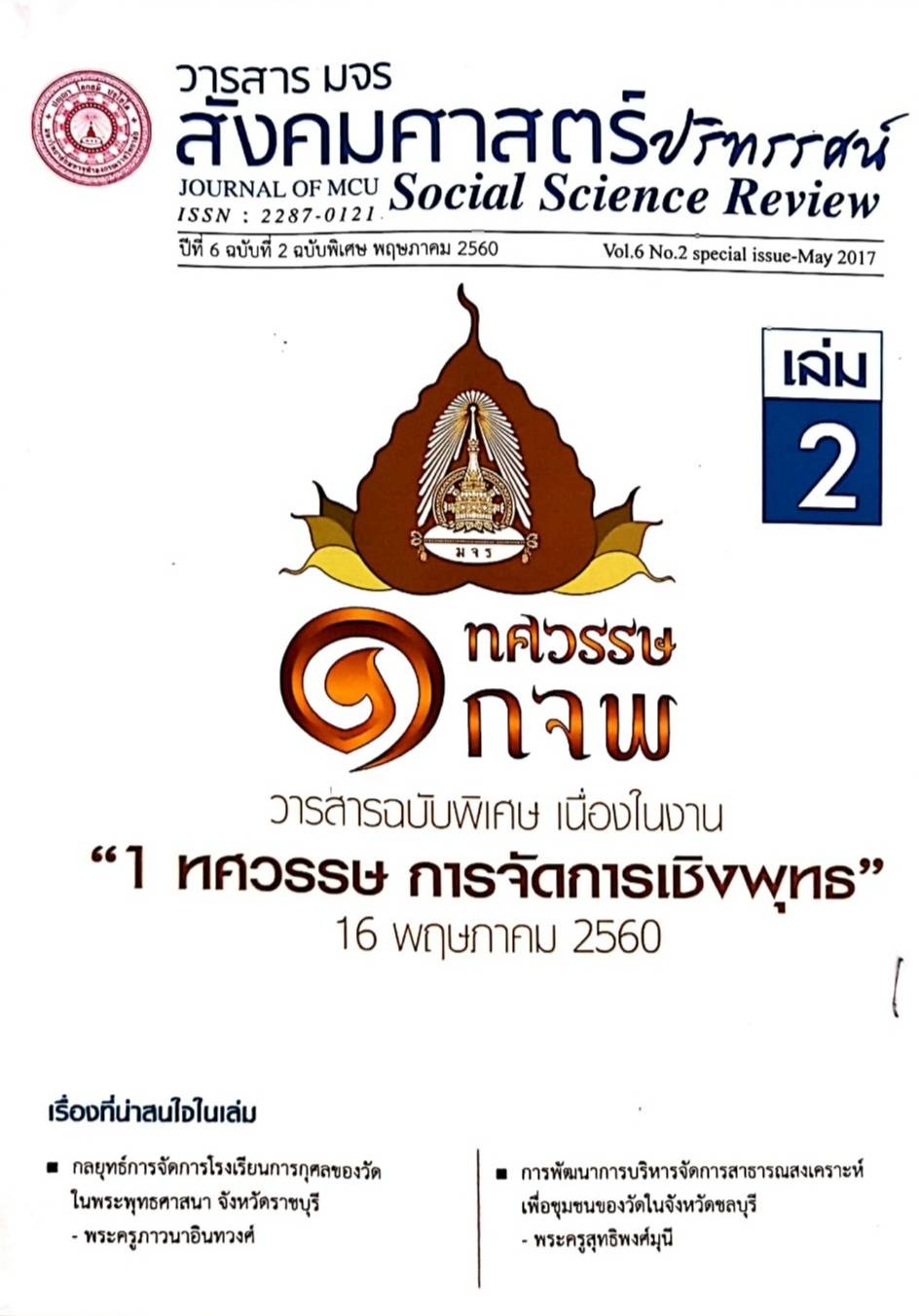ค่ายมวยไทย: รูปแบบการพัฒนาการจัดการศิลปะการต่อสู้เพื่ออนุรักษ์และสืบสาน มวยไทยในกรุงเทพมหานคร
คำสำคัญ:
อนุรักษ์ การจัดการ ศิลปะการต่อสู้ รูปแบบ มวยไทยบทคัดย่อ
การวิจัยนี้มีความมุ่งหมายเพื่อศึกษาความเป็นมาและสภาพของค่ายมวยไทย ศึกษาปัญหาและแนวทางการพัฒนาค่ายมวยไทยและเพื่อศึกษารูปแบบการพัฒนาการจัดการศิลปะการต่อสู้เพื่ออนุรักษ์และสืบสานมวยไทยในค่ายมวยไทยในกรุงเทพมหานครที่มีค่ายมวยไทยมากที่สุดกลุ่มตัวอย่างที่ใช้ในการวิจัย ประกอบด้วยค่ายมวยที่มีชื่อเสียง 6 ค่าย เก็บรวบรวมข้อมูลในภาคสนามด้วยการสัมภาษณ์ สังเกต สนทนากลุ่มและการประชุมเชิงปฏิบัติการ วิเคราะห์ข้อมูลเชิงคุณภาพด้วยวิธีการวิเคราะห์แบบอุปนัยและนาเสนอผลการวิจัยในแบบพรรณนาวิเคราะห์
ผลการวิจัยครั้งนี้พบว่า ค่ายมวยเกิดขึ้นมาพร้อม ๆ กับครูมวย หัวหน้าค่ายจะทามวยด้วยใจรักศิลปะแม่ไม้มวยไทยเป็นหลักเบื้องต้น และเจ้าของค่ายมีทั้งที่เป็นนักมวยเก่ามาก่อนและไม่ได้เป็นนักมวยเก่ามาก่อน ค่ายมวยไทยมีปัญหาการขาดครูมวยที่มีความสามารถในการฝึกสอน ขาดการจัดการที่ดี ขาดการพัฒนาการทางกายตามหลักวิทยาศาสตร์การกีฬา การฝึกสอนแม่ไม้มวยไทยไม่เป็นระบบตามความสามารถของผู้เรียน ละเลยพิธีกรรมและขนบธรรมเนียมที่ดีของมวยไทย เน้นการต่อสู้มากกว่าการกีฬา ส่งเสริมการชกเพื่อเอาใจนักการพนันทั้งหลายที่เข้าไปเล่นการพนันมวยไทย และขาดการส่งเสริมมวยไทยในเชิงธุรกิจ รูปแบบการพัฒนาการจัดการศิลปะการต่อสู้เพื่ออนุรักษ์และสืบสานมวยไทยในค่ายมวยไทยกรุงเทพมหานครเท่านั้น มีเป้าหมายที่จะให้มีการพัฒนา
ศิลปะการต่อสู้ในค่ายมวยเพื่ออนุรักษ์และสืบสานมวยไทยอย่างยั่งยืน ดำเนินการเป็นทางพื้นฐานขั้นที่ 4 แนวทางประกอบด้วย การสร้างความพร้อมของสถานที่เครื่องมือ อุปกรณ์ การบริหารจัดการที่ดี การสร้างรายได้และอาชีพ และการส่งเสริมการพัฒนาทรัพยากรบุคคล แนวทางเพื่อการพัฒนา 5แนวทาง ประกอบด้วย การอนุรักษ์ยอดมวยไทย การจัดเวทีที่ได้มาตรฐาน การสืบทอดภูมิปัญญามวยไทย การบ่มเพาะความเชื่อ ธรรมเนียมและพิธีกรรมของมวยไทย และการสร้างความยั่งยืนของการพัฒนา ซึ่งต้องพัฒนาภายใต้ความตระหนักในความสำคัญของมวยไทย ความมีใจรักมวยไทยของหัวหน้าค่ายและความสำเร็จของการดาเนินการธุรกิจค่ายมวยไทย สรุปว่า ค่ายมวยไทยมี ความสำคัญต่อการพัฒนาและการสืบสานศิลปะการต่อสู้เพื่ออนุรักษ์และสืบสานมวยไทย ค่ายมวยไทยมีข้อจากัดเกี่ยวกับมาตรฐานและความสามารถในการบริหารจัดการภูมิปัญญามวยไทย รูปแบบการพัฒนาการจัดการศิลปะการต่อสู้เพื่ออนุรักษ์และสืบสานมวยไทย ให้ยังคงความเป็นภูมิปัญญาไทยและเอกลักษณ์ของชาติไทย จึงต้องดาเนินการด้วยการอนุรักษ์สั่งสมยอดมวย พัฒนามาตรฐานเวที จัดการภูมิปัญญา สืบสานประเพณีพิธีกรรมมวยไทยและสร้างความยั่งยืนของการพัฒนา ควบคู่กับการพัฒนามาตรฐานค่าย สร้างรายได้ การพัฒนาบุคลากรมืออาชีพและการจัดการค่ายที่ดีเป็นสำคัญ
เอกสารอ้างอิง
Henry, M. (2013). Development of a Muay Thai enthusiast: An interpretation of Alfred North Whitehead's theory of learning. Masters thesis, Department of Educational Foundations, University of Saskatchewan.
Kitiarsa, P. (2005). Lives of hunting dogs: Muai Thai and the politics of Thai masculinities. South East Asia Research, pp. 57-90.
Moore, T. & Mousel, T. (2008). Muay Thai. London: New Holland Publishers.
Myers, T. D. 2007 Cultural differences in judging Muay Thai. Annual Conference of the British Association of Sport and Exercise Sciences Abstracts. Journal of Sports Sciences, 25, 235-369.
Myers, T., Balmer, N., Nevill, A. and Al-Nakeeb, Y. (2013). Techniques used by elite Thai and UK Muay Thai fighters: An analysis and simulation. Advances in Physical Education, 3(04): 175.
Oonthong, C. (2004). 21st Century Muay Thai. Masters Thesis, Nakhon Pathom Rajabhat University: Nakhon Pathom.
Pasuk, C. (1991). The result of exercise with Mae Mai Muay Thai for dynamic ability development. Masters Thesis, Srinakharinwirot University, Bangkok.
Poksap, P. & Poksap, A. (2003). Muay Thai. Bangkok: A.P. Graphic Design and Printing.
Saengsawang, P., Siladech, C. and Laxanaphisuth, P. (2015). The history and development of Muaythai Boran. Journal of Sports Science, 3: 148-154.
Thueyoo, A. (2011). Thai boxing criteria standard development in Thailand. PhD Thesis, Chulalongkorn University, Bangkok.
Vail, P. (2014). Muay Thai: inventing tradition for a national symbol. SOJOURN:Journal of Social Issues in Southeast Asia, 29(3): 509-553.
Van Schuyver, M., & Villalobos, P. S. (2002). Fighting strategies of Muay Thai: Secrets of Thailand's boxing camps. New York: Paladin Press.
Woodward, K. (2015). Being There and the Culture of Boxing. In The Politics of In/Visibility, 24-39. London: Palgrave Macmillan UK.
Yuvanont, P., Buristrakul, P. and Kittimetheekul, N. (2010). Audience satisfaction management of Thai Boxing in Thailand: A case study of Lumpini and Ratchadamnern Stadiums. Featured Research in Sport Entertainment and Venues Tomorrow. Columbia, SC, 50.
ดาวน์โหลด
เผยแพร่แล้ว
รูปแบบการอ้างอิง
ฉบับ
ประเภทบทความ
สัญญาอนุญาต
ลิขสิทธิ์ (c) 2020 วารสาร มจร สังคมศาสตร์ปริทรรศน์

อนุญาตภายใต้เงื่อนไข Creative Commons Attribution-NonCommercial-NoDerivatives 4.0 International License.
เพื่อให้เป็นไปตามกฎหมายลิขสิทธิ์ ผู้นิพนธ์ทุกท่านต้องลงลายมือชื่อในแบบฟอร์มใบมอบลิขสิทธิ์บทความให้แก่วารสารฯ พร้อมกับบทความต้นฉบับที่ได้แก้ไขครั้งสุดท้าย นอกจากนี้ ผู้นิพนธ์ทุกท่านต้องยืนยันว่าบทความต้นฉบับที่ส่งมาตีพิมพ์นั้น ได้ส่งมาตีพิมพ์เฉพาะในวารสาร มจร สังคมศาสตร์ปริทรรศน์ เพียงแห่งเดียวเท่านั้น หากมีการใช้ภาพหรือตารางหรือเนื้อหาอื่นๆ ของผู้นิพนธ์อื่นที่ปรากฏในสิ่งตีพิมพ์อื่นมาแล้ว ผู้นิพนธ์ต้องขออนุญาตเจ้าของลิขสิทธิ์ก่อน พร้อมทั้งแสดงหนังสือที่ได้รับการยินยอมต่อบรรณาธิการ ก่อนที่บทความจะได้รับการตีพิมพ์ หากไม่เป็นไปตามข้อกำหนดเบื้องต้น ทางวารสารจะถอดบทความของท่านออกโดยไม่มีข้อยกเว้นใดๆ ทั้งสิ้น





